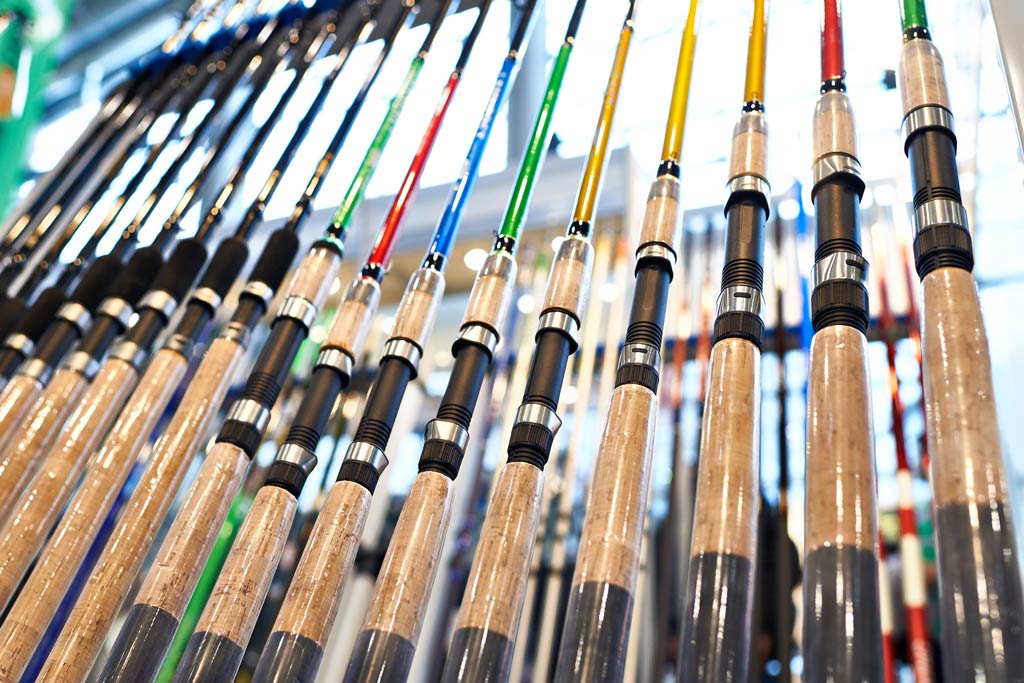We’ve covered bobbers and we’ve written about sinkers. Now it’s time time to look at what might be the most important part of any fishing endeavor: the rod.
The first consideration when choosing a fishing rod is length. Fishing rods come in lengths ranging anywhere from 4 to 14 feet. The length of the rod is a major contributing factor to how far you will be able to cast.

However, this ability comes with trade-offs. Generally speaking, the longer the rod the longer the cast, but they are also much harder to manipulate. Conversely, a shorter rod limits how far you can throw the line, although you will gain more control of your cast. The consensus among seasoned anglers is that a seven-foot rod is the best all-purpose choice and is ideal for beginners.
Rod materials play an important part in how a rod performs, and the most common materials are fiberglass, graphite, or a combination of the two.
Fiberglass Rods
Fiberglass fishing rods have been used for many years. Their strength and durability have made them the “reliable” choice. Since they are easy to manufacture, they are relatively inexpensive, which makes them a satisfactory choice for beginning anglers.
There are, however, some drawbacks to using fiberglass rods, because they are quite pliable, they offer limited feedback, meaning it is harder to know when you have a lighter bite. They also happen to be considerably heavier than graphite or composite rods, which could be a problem if you are having to spend much time reeling in the big one.
Graphite Rods
Graphite rods are quite popular and have been around for nearly fifty years, and are a good choice if you are looking for a lighter rod.
There are some misconceptions about graphite rods:
These rods have markers stamped on them to identify the different degrees of stiffness (Modulus), such as IM6, IM7, and IM8, A larger the modulus means stiffer the material. What this means is that using a stiffer graphite, the manufacturers can achieve more stiffness with less graphite, which results in a lighter rod.
The common misconception is that an IM8 rod will be inherently stiffer than an IM6 rod. Both rods will have the same stiffness, but the IM8 rod will be lighter.
There are some trade-offs with graphite rods, although their stiffness makes them more sensitive, the extra stiffness means they are more brittle, thus prone to breakage, and they are somewhat expensive.
Composite Rods
These rods are constructed with fiberglass and graphite and offer maximum performance. This mixture provides excellent flexibility and strength, while, at the same time, offering sensitivity and less weight. These qualities allow you to use heavier line on a smaller line-rated rod. Although they are the most expensive of the three types, they are extremely versatile.
Because they’re so versatile, composite rods are a great choice if you’re used to fishing a variety of different waters. As you’d expect, composite rods are the most expensive variety out there.
Another metric for selecting a rod is the action of the rod. Action determines how much and where a rod will bend, and is dictated by the material from which it is constructed and the shape of the rod. Action also regulates the speed at which the rod goes from “loaded” back to its original position, hence the terms fast, medium, and slow.
Fast-Action
Fast-action (Heavy) rods bend right below the tip and are sensitive to the slightest nibble. They transmit vibrations directly to your hand, providing a quickly and strongly set hook. Due to their fast action and rod strength, they are excellent for spurring fish in covered areas and reeling in large fish.
Medium-Action
Medium-action rods bend at the “top half”. They provide decent hook-setting and feedback (sensitivity) and allow you to make a relatively long cast. Because The action is somewhat slower than fast action rods, medium action rods give the fish more time to bite.
Slow-Action
Slow-action (Light) rods bend from the tip to the butt of the rod, which makes trying to reel in the tiniest of fish, enjoyable. These rods are perfect for panfish or trout fishing.
Slow action rods allow for truly impressive casts. One thing to keep in mind is matching the size of the lure to the rod. It is recommended you use the smallest lure possible because slow action rods take longer to set the hook.
The slow action means it is more difficult to set the hook, the amount the rod bends requires pulling the rod further back. However, once the fish has the hook in its mouth, it is easier to maintain proper tension.
Along with action, another criteria is rod power, which is the rod’s ability to withstand pressure.
You should use a heavier line with a heavy rod and, accordingly, a light line with a light rod. The rule of thumb is to adhere to the markings on the rod. The first set of three or four numbers indicate the length of the rod. The second type of action comes second, followed by the recommended line and lure weights. Typical marking will look like this: Spin MH 732 Line Wt 10-15 lb, Lure Wt ¼ – ¾ oz, which means: Medium heavy 7′ 3″ spinning rod, that can accept 10–15 pound line, and lures ranging from ¼ to ¾ ounces. Note: The number “2” after “73” indicates a two-part rod.
Using too heavy a line may result in the rod breaking and conversely using too light a line may cause the line to break.
Rod power is categorized as Ultra-Light, Light, to Medium, Medium-Heavy, to Heavy, and Ultra-Heavy.
The previous parameters were for the rod “blank,” which is the shaft of the rod. There are two more parameters to consider when choosing a rod, First is rod guides, and second is the handle.
Rod Guides- Rod guides are generally constructed of metal on the outside, and have a ceramic coating on the inside, which reduces friction. You are advised not to buy a rod that has guides made only of metal.
Rod Handle- a typical rod handle is made with cork or EVA foam. Cork is considered to be more comfortable to hold and transmits nearly three times as much vibration as foam.
The downside to cork is it is not as durable as foam, and is harder to clean than foam.
Carbon fiber handles are now available, which provides excellent sensitivity and are very durable, but they are much more expensive.
Next week, we will discuss how to select the right reel for your fishing rod.










